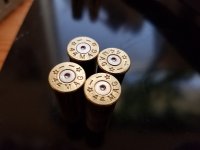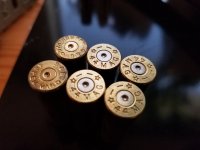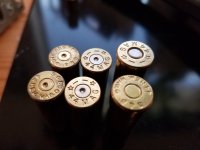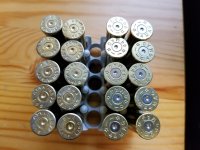Not a reloading question per se, as these are not reloads. But I figured this would be the best place to ask it since it has to do with pressure signs.
Was shooting some real hot buffalo bore (305 grain at 1325 fps) loads earlier today in my model 29. Figured it'd be a good bear load and did some research before buying it. The guy at buffalo bore as well as a gunsmith I talked to both said it should be safe to fire in my gun, provided I only did so sparingly to avoid accelerating wear too much.
Well, I just fired them for the first time at the range today. Not sure if its just my imagination, but I thought some of these primers looked a little flat, and I'm concerned these loads may be pushing it a little too far in terms of pressure.
Not too worried, as I have not had issues with primers blowing out, cracked cases, or anything else of that nature. But I'd rather not get to that point later on.
So my question is as follows. Do these primers look normal for a full power load? Or do you see indicators of dangerous pressure levels.
For reference, I've attached not only images of the spent cases, but also spent cases compared to unfired ones. In addition, I attached a picture of the buffalo bore (silver primer) next to a relatively mild load (gold primer) that I know beyond even the slightest doubt to be a safe pressure.
Sorry if this is a stupid question or I seem paranoid. I'm new to revolvers, and would rather ease my way into these super hot loads than risk causing a safety issue or damaging my gun. And no, I don't plan to get any hotter than this! For that I'd buy a redhawk! Just want to make to make sure these are truly "full house" loads and not "bomb in the house" accidents waiting to happen before continuing to use them.
Was shooting some real hot buffalo bore (305 grain at 1325 fps) loads earlier today in my model 29. Figured it'd be a good bear load and did some research before buying it. The guy at buffalo bore as well as a gunsmith I talked to both said it should be safe to fire in my gun, provided I only did so sparingly to avoid accelerating wear too much.
Well, I just fired them for the first time at the range today. Not sure if its just my imagination, but I thought some of these primers looked a little flat, and I'm concerned these loads may be pushing it a little too far in terms of pressure.
Not too worried, as I have not had issues with primers blowing out, cracked cases, or anything else of that nature. But I'd rather not get to that point later on.
So my question is as follows. Do these primers look normal for a full power load? Or do you see indicators of dangerous pressure levels.
For reference, I've attached not only images of the spent cases, but also spent cases compared to unfired ones. In addition, I attached a picture of the buffalo bore (silver primer) next to a relatively mild load (gold primer) that I know beyond even the slightest doubt to be a safe pressure.
Sorry if this is a stupid question or I seem paranoid. I'm new to revolvers, and would rather ease my way into these super hot loads than risk causing a safety issue or damaging my gun. And no, I don't plan to get any hotter than this! For that I'd buy a redhawk! Just want to make to make sure these are truly "full house" loads and not "bomb in the house" accidents waiting to happen before continuing to use them.
Attachments
Last edited:





